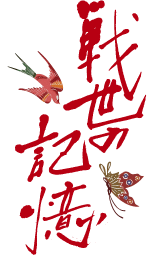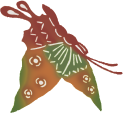
“War experiences in Nakachi, Kumejima”
“War experiences in Nakachi, Kumejima”
Shouhan Nakamura, 85 years old
(Place of birth: Nakachi, Kumejima Village, Okinawa Prefecture)
Militarism prevailed in people’s minds back then. We were always told by authority figures, “Fight ceaselessly.” That was the tide in the society. We were taught flag semaphore signaling; and during the athletic meet, the people in the young men’s and women’s associations used a wooden replica of a rifle to stab the straw figures that looked like Winston Churchill, Franklin Roosevelt and Chiang Kai-shek.
When the war started, I was so scared. Air raids were so frightening and at eight o’clock in the morning the Grumman airplanes always flew over and attacked us. There were many fishing ships at the currently-called Kanegusuku-kou (Kanegusuku Port) and they were attacked as well. When we, the third graders and fourth graders, were being instructed to hide in an air-raid drill, we saw the ships destroyed.
The original Gushikawa-kou (Guishikawa Port) was destroyed completely. Gushikawa Port was attacked by four planes which flew over at around five o’clock in the afternoon and opened fire. Then, they seemed to fly away toward the south, but they came back in a four-plane formation and opened fire again. The father of one of my relatives was lying down in his house and he was killed. I saw numerous pieces of his flesh scattered in the house. It was very scary.
We were hiding ourselves in the shadow of leaves in the mountain. As the Americans were up in the air attacking us, many cartridge cases fell in front of us. I remember that I tried to pick one up, but it was just too hot to touch.
During an air raid, we hid in an air-raid shelter and when they landed, we hid in a gama (a natural cave).
Women, mainly mothers, could not use fire in the daytime as the Americans could easily find us due to the smoke. Food had to be prepared at night.
When taking refuge, we always moved with a couple of groups from a small cave to a big cave called Haiehjah-gama. I saw some people evacuated from Torishima, Nakandakari and the surrounding area.
The Japanese soldiers were based in the villages in the mountain. The residents were forced to build encampments in turn. The Japanese soldiers called it commandeering. Without any heavy equipment available, the residents built the encampments with their hands. If they disobeyed the soldiers, the residents were not sure what would have happened to them in return.
We called the Japanese soldiers “the mountain corps.” It was my impression that the Japanese soldiers were busy managing the residents and never had a shooting battle against the American corps. While we were hiding in an air-raid shelter, we saw the Japanese corps at the dam located between Gushikawa and Nakachi and the American corps firing cannon shells at each other. However, I believe that the Japanese corps only had a few cannon shells to fire because the battle of exchanging the cannon shells lasted only for a short while.
(The residents killed by Japanese soldiers)
There was a ten-year-old boy called Kazuo Tanikawa. He was good at sports and smart, but he and his whole family were suspected of spying and were killed by Japanese soldiers.
The man called Eimei Miyagi who was from the main island of Okinawa, had a house in the north of Kumejima Island and was raising cows on his big farm. He was captured by American reconnaissance troops and taken somewhere. Although he was released at later date, he was suspected of spying by the Japanese soldiers.
As neither the headman of Kitahara Ward nor the headman of the civil defense unit knew that Miyagi was taken by the American soldiers, I was not sure who reported it to the Japanese soldier. The Japanese soldier came to Miyagi’s house with the responsible officer of his corps, tied Miyagi with steel wire and burned his house with Miyagi tied inside. I went to his house afterward and found him all tied up and turned into a skeleton. Because of the fear of the mountain corps, even his family members could not go to the house and pick up his remains and Miyagi was left untouched for a while. When we went to his house, Miyagi was turned into a skeleton and no one could pick up his remains for a while.
The commanding officer of the Japanese corps, Kayama, took a young woman who was about 18 years old living in the neighboring village as his wife and was doing selfishly whatever he wanted to do. The residents were supposed to give up their chickens and such to the corps as comfort gifts.
(After the war)
When the war was over, I was truly relieved. The American corps built their army post by bringing the tent sheds together. I went there, got some canned food and exchanged various goods. There was an American corps based around what is now currently called Kumejima High School. When they withdrew, they left drums filled with oil. The residents, in groups of a few guys, took them home by pushing the drums up the rough rocky slope.
(Looking back at the war)
I feel so sorry for the Tanikawa family. All the family members were so kind and humane, it was difficult to find people like that in Okinawa.
(About peace)
If you want to live a peaceful life, you had better not be rich, I believe.
Shouhan Nakamura, 85 years old
(Place of birth: Nakachi, Kumejima Village, Okinawa Prefecture)
Militarism prevailed in people’s minds back then. We were always told by authority figures, “Fight ceaselessly.” That was the tide in the society. We were taught flag semaphore signaling; and during the athletic meet, the people in the young men’s and women’s associations used a wooden replica of a rifle to stab the straw figures that looked like Winston Churchill, Franklin Roosevelt and Chiang Kai-shek.
When the war started, I was so scared. Air raids were so frightening and at eight o’clock in the morning the Grumman airplanes always flew over and attacked us. There were many fishing ships at the currently-called Kanegusuku-kou (Kanegusuku Port) and they were attacked as well. When we, the third graders and fourth graders, were being instructed to hide in an air-raid drill, we saw the ships destroyed.
The original Gushikawa-kou (Guishikawa Port) was destroyed completely. Gushikawa Port was attacked by four planes which flew over at around five o’clock in the afternoon and opened fire. Then, they seemed to fly away toward the south, but they came back in a four-plane formation and opened fire again. The father of one of my relatives was lying down in his house and he was killed. I saw numerous pieces of his flesh scattered in the house. It was very scary.
We were hiding ourselves in the shadow of leaves in the mountain. As the Americans were up in the air attacking us, many cartridge cases fell in front of us. I remember that I tried to pick one up, but it was just too hot to touch.
During an air raid, we hid in an air-raid shelter and when they landed, we hid in a gama (a natural cave).
Women, mainly mothers, could not use fire in the daytime as the Americans could easily find us due to the smoke. Food had to be prepared at night.
When taking refuge, we always moved with a couple of groups from a small cave to a big cave called Haiehjah-gama. I saw some people evacuated from Torishima, Nakandakari and the surrounding area.
The Japanese soldiers were based in the villages in the mountain. The residents were forced to build encampments in turn. The Japanese soldiers called it commandeering. Without any heavy equipment available, the residents built the encampments with their hands. If they disobeyed the soldiers, the residents were not sure what would have happened to them in return.
We called the Japanese soldiers “the mountain corps.” It was my impression that the Japanese soldiers were busy managing the residents and never had a shooting battle against the American corps. While we were hiding in an air-raid shelter, we saw the Japanese corps at the dam located between Gushikawa and Nakachi and the American corps firing cannon shells at each other. However, I believe that the Japanese corps only had a few cannon shells to fire because the battle of exchanging the cannon shells lasted only for a short while.
(The residents killed by Japanese soldiers)
There was a ten-year-old boy called Kazuo Tanikawa. He was good at sports and smart, but he and his whole family were suspected of spying and were killed by Japanese soldiers.
The man called Eimei Miyagi who was from the main island of Okinawa, had a house in the north of Kumejima Island and was raising cows on his big farm. He was captured by American reconnaissance troops and taken somewhere. Although he was released at later date, he was suspected of spying by the Japanese soldiers.
As neither the headman of Kitahara Ward nor the headman of the civil defense unit knew that Miyagi was taken by the American soldiers, I was not sure who reported it to the Japanese soldier. The Japanese soldier came to Miyagi’s house with the responsible officer of his corps, tied Miyagi with steel wire and burned his house with Miyagi tied inside. I went to his house afterward and found him all tied up and turned into a skeleton. Because of the fear of the mountain corps, even his family members could not go to the house and pick up his remains and Miyagi was left untouched for a while. When we went to his house, Miyagi was turned into a skeleton and no one could pick up his remains for a while.
The commanding officer of the Japanese corps, Kayama, took a young woman who was about 18 years old living in the neighboring village as his wife and was doing selfishly whatever he wanted to do. The residents were supposed to give up their chickens and such to the corps as comfort gifts.
(After the war)
When the war was over, I was truly relieved. The American corps built their army post by bringing the tent sheds together. I went there, got some canned food and exchanged various goods. There was an American corps based around what is now currently called Kumejima High School. When they withdrew, they left drums filled with oil. The residents, in groups of a few guys, took them home by pushing the drums up the rough rocky slope.
(Looking back at the war)
I feel so sorry for the Tanikawa family. All the family members were so kind and humane, it was difficult to find people like that in Okinawa.
(About peace)
If you want to live a peaceful life, you had better not be rich, I believe.


